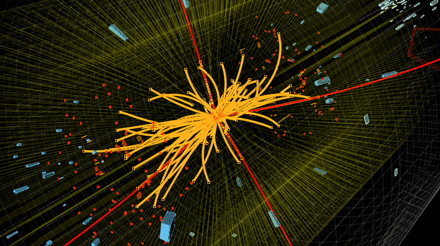SUMMARY
This is AI generated summarization, which may have errors. For context, always refer to the full article.

WASHINGTON DC, United States – A video from Europe’s CERN physics lab, apparently posted mistakenly on the eve of an announcement on the elusive “God Particle,” reveals that a new subatomic particle has been observed in the relevant range.
“We’ve observed a new particle,” Joe Incandela, a spokesman for the European Organization for Nuclear Research (CERN), says in the video that appeared on the Science News website before being picked up elsewhere.
“We have quite strong evidence that there’s something there… To ascertain its properties is still going to take us a bit of time,” Incandela says.
Questioned by a feverish US media, CERN quickly insisted that the video was only one of several that was filmed in advance of Wednesday’s (July 4) hotly awaited announcement, scheduled for 0700 GMT, hinting that some other scenario may unfold.
But Incandela appeared pretty sure of what he is saying in the video, as he pours light on what has become something of a holy grail scientists, physicists in particular.
“But we can see that it decays to two photons, for example, which tells us it’s a boson, it’s a particle with integer spin,” he says.
“And we know its mass is roughly 100 times the mass of the proton…. This is the most massive such particle that exists, if we confirm all of this, which I think we will,” Incandela added.
Analysts pored over the subtle semantic differences in the video that might illustrate CERN’s progress in finding the “God particle,” an elusive sub-atomic particle that is believed to confer mass.
“Note that the language used refers to ‘observation’ NOT ‘discovery’,” wrote Peter Woit, a senior lecturer in mathematics at Columbia University in New York, who linked to a copy of the video on his blog.
“‘Observation’ generally means a lower standard of evidence…. However, it appears that (CERN is) sensibly playing this down, with nothing in the video mentioning the word ‘discovery’ or their decision not to use that word,” he said.
The video hints that CERN’s word choice is indeed intentional.
CERN spokesman Incandela describes their findings as “one of the biggest discoveries…” before correcting himself to add “… or observations of any new phenomena in our field in the last 30 or 40 years.”
The origin of mass (meaning the resistance of an object to being moved) has been fiercely debated for decades.
Finding the Higgs boson would vindicate the so-called Standard Model of physics, a theory that developed in the early 1970s, which says the Universe is made from 12 particles which provide the building blocks for all matter.
The quest to prove, or disprove, the Higgs has been carried out at particle colliders: giant machines that smash protons together and sift through the sub-atomic debris that tumbles out.
The big daddy of these is the Large Hadron Collider (LHC), operated by CERN in a ring-shaped tunnel deep underground near Geneva.
Smashups generated at the LHC briefly generate temperatures 100,000 times hotter than the Sun, replicating the conditions that occurred just after the Universe’s creation in the “Big Bang” nearly 14 billion years ago.
But these concentrations of energy, while violent, occur only at a tiny scale.
Evidence to support the existence of the Higgs is indirect.
In the same way that we can cannot see the wind, we infer its existence and strength from leaves or flags or other objects that it moves. – Agence France-Presse
You might like:
- Why Saturday’s last minute is 61 seconds long
- 3 Chinese astronauts return to Earth
- 4-in-1 AIDS drug gets the OK in clinical trial
Elsewhere in Rappler:
Add a comment
How does this make you feel?
There are no comments yet. Add your comment to start the conversation.